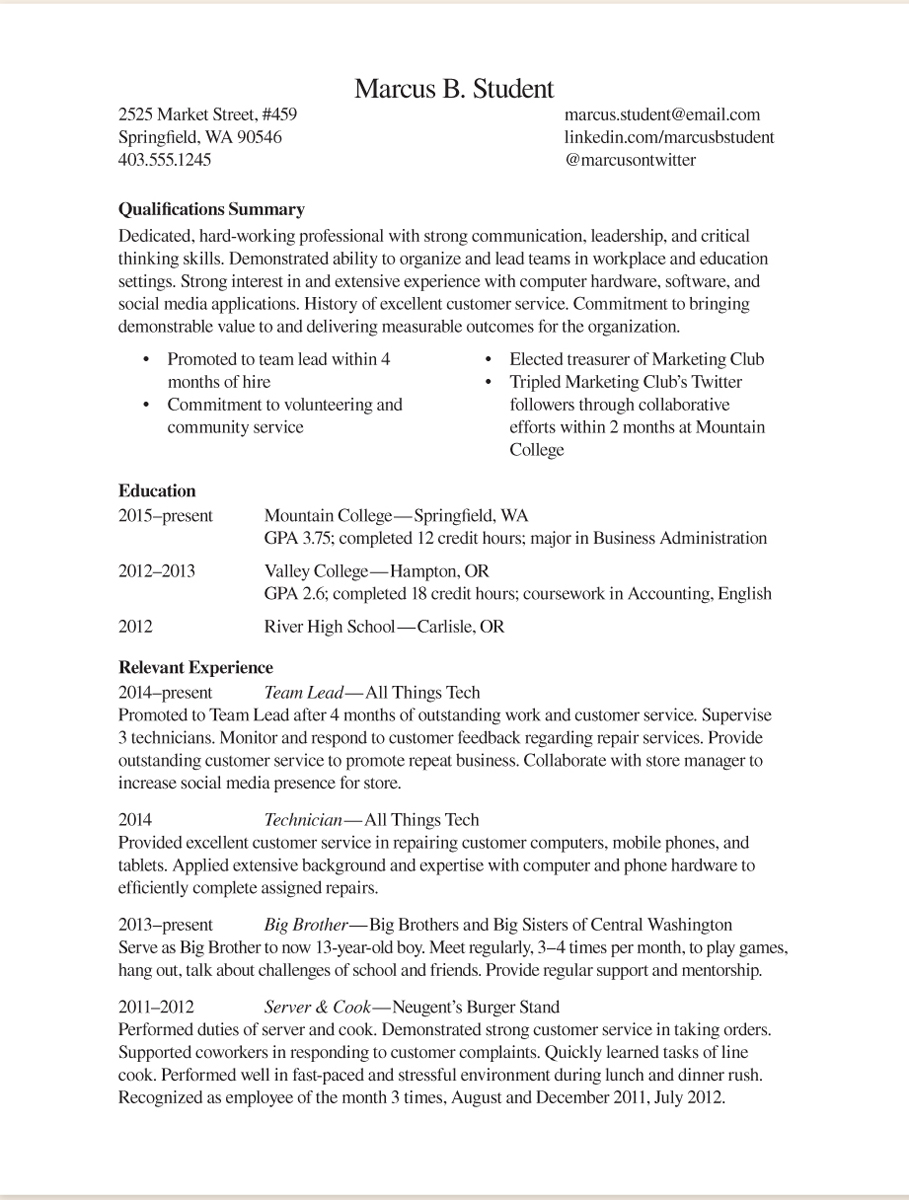Write a Résumé
Résumé: A document that lists your education, work experience, and extracurricular activities.
At the most basic level, your résumé is a summary of your education, work experience, and extracurricular activities. It gives potential employers a sense of your prior experience and qualifications for the position you’re targeting. Recruiters will often skim a candidate’s résumé for this basic information before deciding whether to read more closely, so it’s important that these basics be easy to find in the visual layout of your document.
At a deeper level, your résumé is an opportunity to detail your responsibilities, highlight accomplishments, and spell out transferable skills. It can be challenging to place all pertinent information on a page without it looking cluttered, but the key is to briefly list only the most critical information. You can provide greater details about your experiences in the cover letter or interview. Although most people prefer a one-page résumé, you may need to use two pages if you have a significant amount of work experience and accomplishments. Ultimately, your goal is to show how your qualifications align with the requirements of the job in a clear, professional way.
Résumé Basics
As you can see in Figure A.1, your name and contact information should appear prominently at the top of your résumé. You might also include a link to your LinkedIn profile, Twitter feed, or another element of your online presence if appropriate. And remember that your e-mail address should be professional — you may want to obtain a new one for the job search process.
Many job applicants choose to open their résumé with a summary section. Think of this as a place to tell employers what kind of professional you are. This description should highlight the characteristics and skills that you would bring to a job, while citing previous accomplishments as support for these points. Note that each statement in this section of Figure A.1 begins with a skill or quality that the student has chosen to emphasize. This puts the most important information in a prominent place and makes this section easy for a reader to digest, even if he or she is reading quickly.
Next, add your educational history. This should consist of all the institutions where you’ve completed undergraduate coursework, as well as any technical certifications you hold. On the first line of each entry, list the name of each institution, its location, and your dates of attendance. Underneath this, include your grade point average and area of study. Many students also choose to include their high school name, location, and year of graduation, and some students note the number of college credits they’ve earned, subjects in which they’ve completed substantial coursework, study abroad experience, scholarships, or even Honor Society membership. If you can fit them in, these kinds of details make your résumé more informative and help to spark conversation with an interviewer.

Chronological or Functional
After your education section, list your work and extracurricular experience in one of two styles: chronological or functional. On a chronological résumé, entries simply appear in reverse chronological order, with your current or most recent experience first. Figure A.1 shows a chronological résumé, a style commonly used by college students. This format is a great choice for students who have taken on increasingly complex responsibilities over time, as it demonstrates this growth in a linear fashion. A chronological résumé also makes sense for students whose experiences are all somewhat relevant to the positions for which they’re applying.
Chronological Résumé: A résumé that lists work and extracurricular experiences in reverse chronological order, with the most recent appearing first.
In a functional résumé entries are grouped based on the nature of the experience they reflect rather than the order in which they occurred. This style of résumé can be helpful when only some of your past experiences are directly related to the position you’re seeking. For example, a student applying for a research assistant position may wish to highlight a summer research position from several years ago more prominently than her current part-time job in food service. To do so, she might develop a “Related Experience” section that includes work experience involving data collection and analysis, and then an “Other Experience” section that includes the rest of her work history. Functional résumés can also be useful for applicants applying for different types of positions. A student who is applying for both marketing and editing jobs, for example, might develop two different functional résumés: one for marketing positions in which the “Related Experience” section cites social media accomplishments, and another for editing positions in which the “Related Experience” section details his work in the college writing center and involvement with the school newspaper.
Functional Résumé: A résumé that groups entries by skills and experiences.
No matter which style you choose, you’ll need to develop descriptions of your responsibilities and accomplishments in each position you’ve held. As you can see in Figure A.1, the style used for writing a résumé is quite different than the style used for written course assignments. Résumés use short phrases rather than complete sentences and begin each statement with an active verb. By describing what you accomplished in such vivid terms, you’ll help employers visualize how your skills might apply to their open positions.
In addition to the sample résumé provided in this section, you can access résumé examples online through your career center or by doing your own online search (type “sample résumé” into a search engine). Your local library or bookstore may also have résumé-writing books with samples of both chronological and functional résumés.